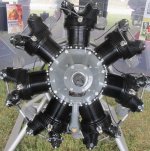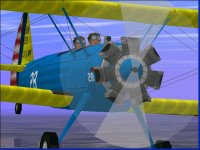aleatorylamp
Charter Member
Possible Military 280 Hp version?
Hello all, Hello Smilo,
I made a mistake before - the possible military 280Hp version, as argumented on the old Stearman thread, would not be for a Navy version, but for an Army Corps one. The Navy never had non-standard ones.
Two or three sources not only plausibly mention the existence of 255 units manufactured 1940-41 with the more powerful engine and designated as PT-13B, but also quote the exact production serial numbers of the aircraft produced with this engine. Also mentioned, are 6 Army Corps units of the PT-13A type that were re-engined with 280Hp engines and re-designated PT-13C.
Seemingly, the installation of this engine in the production line, coincided with a serious shortage of the normal engines used for this aircraft.
Now, in CFS1, using the current Stearman 16-degree pitch propeller and .air file, and entering the engine parameters of the 280 Hp Lycoming R-680-11 for the same airframe, the sea-level top speed that comes out with no further alterations is 135 mph!
This is curious, because it is the same top speed that seems to be erroneously quoted by several sources for the normal 220-225 Hp military versions, which should be 124 mph. So obviously there is something behind this error.
Anyway, it will be impossible to find a historically correct registration number corresponding to an Army Corps Stearman motorized with the stronger engine, because there were no official specifications to the production of these units. They seem to have been disguised as normal ones, with the exception of the strange 135 mph top speed that often crops up.
So, if I were to provide a more powerful Army Corps Stearman, the registration would have to be a fictitious one. On the other hand, given that a more powerful acrobatic Stearman is planned anyway, a more powerful military version might not be required. However, should anyone be interested in one, I would of course supply it!
Cheers,
Aleatorylamp
Hello all, Hello Smilo,
I made a mistake before - the possible military 280Hp version, as argumented on the old Stearman thread, would not be for a Navy version, but for an Army Corps one. The Navy never had non-standard ones.
Two or three sources not only plausibly mention the existence of 255 units manufactured 1940-41 with the more powerful engine and designated as PT-13B, but also quote the exact production serial numbers of the aircraft produced with this engine. Also mentioned, are 6 Army Corps units of the PT-13A type that were re-engined with 280Hp engines and re-designated PT-13C.
Seemingly, the installation of this engine in the production line, coincided with a serious shortage of the normal engines used for this aircraft.
Now, in CFS1, using the current Stearman 16-degree pitch propeller and .air file, and entering the engine parameters of the 280 Hp Lycoming R-680-11 for the same airframe, the sea-level top speed that comes out with no further alterations is 135 mph!
This is curious, because it is the same top speed that seems to be erroneously quoted by several sources for the normal 220-225 Hp military versions, which should be 124 mph. So obviously there is something behind this error.
Anyway, it will be impossible to find a historically correct registration number corresponding to an Army Corps Stearman motorized with the stronger engine, because there were no official specifications to the production of these units. They seem to have been disguised as normal ones, with the exception of the strange 135 mph top speed that often crops up.
So, if I were to provide a more powerful Army Corps Stearman, the registration would have to be a fictitious one. On the other hand, given that a more powerful acrobatic Stearman is planned anyway, a more powerful military version might not be required. However, should anyone be interested in one, I would of course supply it!
Cheers,
Aleatorylamp









